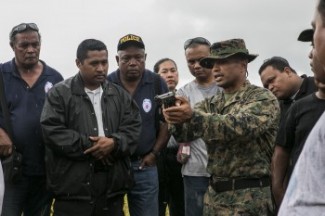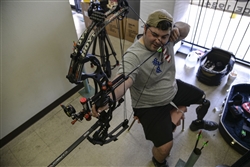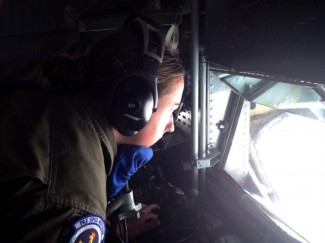Meet Your Military
- Details
- Hits: 3854
 PHOTO: Air Force Senior Airman Edward Lomelin and Air Force Airman 1st Class Chris Lomelin play video games at the home they share in Bitburg, Germany, Sept. 27, 2014.SPANGDAHLEM AIR BASE, Germany – A pair of brothers serving together with the 606th Air Control Squadron here is preparing to deploy together. U.S. Air Force photo by Airman 1st Class Kyle Gese Air Force Senior Airman Edward Lomelin and Air Force Airman 1st Class Chris Lomelin grew up in Austin, Texas, and struggled early in their childhood after their parents’ divorce. The children moved in with their mother, and Edward stepped in as the role model for his younger siblings.
PHOTO: Air Force Senior Airman Edward Lomelin and Air Force Airman 1st Class Chris Lomelin play video games at the home they share in Bitburg, Germany, Sept. 27, 2014.SPANGDAHLEM AIR BASE, Germany – A pair of brothers serving together with the 606th Air Control Squadron here is preparing to deploy together. U.S. Air Force photo by Airman 1st Class Kyle Gese Air Force Senior Airman Edward Lomelin and Air Force Airman 1st Class Chris Lomelin grew up in Austin, Texas, and struggled early in their childhood after their parents’ divorce. The children moved in with their mother, and Edward stepped in as the role model for his younger siblings.
This new responsibility forced him to grow up quickly to help his family through their struggles, he said. Years later, Edward enlisted in the Air Force, and he serves as a radio frequencies transmissions systems technician with the 606th ACS. His mother said she was honored he made the decision to serve his country, and that she knew he would excel in his career.
Read more: Meet Your Military: Brothers Serve and Prepare to Deploy Together
- Details
- Hits: 2556
 PHOTO: Marine Corps Staff Sgt. Milton Donatus, second from right, instructs Palau national law enforcement officers on the operations of the M9A1 9 mm service pistol in Irai, Palau, Sept. 16, 2014.IRAI, Palau– Bedtime stories can have an impact on children’s imaginations. For many young people, hearing tales of fictitious characters like “Peter Pan” or “Jack and the Beanstalk” can create the desire to experience Peter’s or Jack’s extraordinary adventures. Donatus is a native of Ngaraard, Palau. U.S. Marine Corps photo by Lance Cpl. Drew Tech For one boy from Ngaraard, Palau, bedtime stories were not about fighting pirates or giants. This boy was told stories of combat and the U.S. Marines at the Battle of Peleliu during World War II. That boy was Milton Donatus, and the stories his grandmother told him as a child spawned a lifelong dream to become a U.S. Marine.
PHOTO: Marine Corps Staff Sgt. Milton Donatus, second from right, instructs Palau national law enforcement officers on the operations of the M9A1 9 mm service pistol in Irai, Palau, Sept. 16, 2014.IRAI, Palau– Bedtime stories can have an impact on children’s imaginations. For many young people, hearing tales of fictitious characters like “Peter Pan” or “Jack and the Beanstalk” can create the desire to experience Peter’s or Jack’s extraordinary adventures. Donatus is a native of Ngaraard, Palau. U.S. Marine Corps photo by Lance Cpl. Drew Tech For one boy from Ngaraard, Palau, bedtime stories were not about fighting pirates or giants. This boy was told stories of combat and the U.S. Marines at the Battle of Peleliu during World War II. That boy was Milton Donatus, and the stories his grandmother told him as a child spawned a lifelong dream to become a U.S. Marine.
“Every time my grandmother would talk about war, the Marines came up,” said Donatus, the training chief with Combat Logistics Detachment 379, Combat Logistics Regiment 37, 3rd Marine Logistics Group, 3rd Marine Expeditionary Force. Idolized Marines “The Marines were always talked about as the saviors and the best [warriors] ever, so growing up, I didn’t know about any other military,” he added. “I only knew about the Marines, and that I wanted to be one.” Shortly after graduating from high school in 1995, Donatus moved to Guam to pursue his dream, and in May 2000, he enlisted in the Marine Corps. His career has seen him rise to the rank of staff sergeant and has brought him aboard the USNS Sacagawea as part of exercise T-AKE 14-2, a maritime pre-positioned force, multinational theater security cooperation event that deploys from the Japanese island of Okinawa to conduct training exercises.
Read more: Meet Your Military: Palau Native Marine Returns to Island Home
- Details
- Hits: 2631
 PHOTO: Pfc. Derek Jones, Pvt. Joshua Anderson and Pfc. DeAndre Kinlaw, all now 19 years old, graduated from the Army’s Food Service Specialist Course on Sept. 10, 2014. FORT LEE, Va– In middle school, three students made a pact to attend high school together, play football together, enroll in college together and follow the same career path. The Jacksonville, Fla., natives have attended middle school, high school and college together and are now embarking on a stint with the Florida National Guard. U.S. Army photo by Terrance Bell “We were in the eighth grade sitting at a table, and we planned our whole lives out right there that day in class,” recalled Army Pvt. DeAndre Kinlaw, a member of the trio. One could argue their ambitions were simply notions of pre-adolescent romanticism, but it was far more than that. It was about extending their reach far beyond the familiar, actively pursuing goals and drawing inspiration from each other along the way.
PHOTO: Pfc. Derek Jones, Pvt. Joshua Anderson and Pfc. DeAndre Kinlaw, all now 19 years old, graduated from the Army’s Food Service Specialist Course on Sept. 10, 2014. FORT LEE, Va– In middle school, three students made a pact to attend high school together, play football together, enroll in college together and follow the same career path. The Jacksonville, Fla., natives have attended middle school, high school and college together and are now embarking on a stint with the Florida National Guard. U.S. Army photo by Terrance Bell “We were in the eighth grade sitting at a table, and we planned our whole lives out right there that day in class,” recalled Army Pvt. DeAndre Kinlaw, a member of the trio. One could argue their ambitions were simply notions of pre-adolescent romanticism, but it was far more than that. It was about extending their reach far beyond the familiar, actively pursuing goals and drawing inspiration from each other along the way.
Those dynamics also played part in the decision to take the plan one step further, joining the Army National Guard and completing basic combat and advanced individual training together as members of the same units. The three 19 year olds -- Pvt. Joshua Anderson, Kinlaw and Pfc. Derek Jones -- graduated Sept. 10 after completing the Quartermaster School’s Food Service Specialist Course as members of Tango Company, 266th Quartermaster Battalion. They are now on leave in their hometown of Jacksonville, Florida. Resilience, teamwork, common purpose Army Capt. Constance Marable, Tango Company commander, manages more than 400 soldiers at any one time.
Read more: Meet Your Military: Food Services Trio Inseparable Since 8th Grade
- Details
- Hits: 2713
 PHOTO: Air Force Staff Sgt. Seth Pena readies his compound bow to strike a target 25 meters away in San Antonio, Sept. 14, 2014.SAN ANTONIO – Air Force Staff Sgt. Seth Pena, a highly decorated tactical air control party member who is noted for calling in coordinated close support airstrikes that killed up to 70 Taliban members in one fight, sat down with a crossbow draped across his lap and a target 25 meters in front of him, reminiscing about the night that changed his life forever. Pena will compete at the 2014 Warrior Games, taking place from Sept. 28 to Oct. 4, in Colorado Springs, Colo. U.S. Air Force photo by Senior Airman Michael Ellis "I have gone on multiple deployments, defeated the Taliban; I never thought another American would do this to me," he said. One night while Pena was riding his motorcycle, a drunk driver ran a red light and crashed into him. As Pena was flung from his bike, the driver attempted to flee, but was apprehended by a service member who witnessed the incident. Pena doesn't remember the event. He suffered a traumatic brain injury, multiple broken bones and fractures, and he lost a lot of blood. He died immediately at the scene, but was resuscitated once medical personnel arrived. "I actually died twice," Pena said with a sobering tone.
PHOTO: Air Force Staff Sgt. Seth Pena readies his compound bow to strike a target 25 meters away in San Antonio, Sept. 14, 2014.SAN ANTONIO – Air Force Staff Sgt. Seth Pena, a highly decorated tactical air control party member who is noted for calling in coordinated close support airstrikes that killed up to 70 Taliban members in one fight, sat down with a crossbow draped across his lap and a target 25 meters in front of him, reminiscing about the night that changed his life forever. Pena will compete at the 2014 Warrior Games, taking place from Sept. 28 to Oct. 4, in Colorado Springs, Colo. U.S. Air Force photo by Senior Airman Michael Ellis "I have gone on multiple deployments, defeated the Taliban; I never thought another American would do this to me," he said. One night while Pena was riding his motorcycle, a drunk driver ran a red light and crashed into him. As Pena was flung from his bike, the driver attempted to flee, but was apprehended by a service member who witnessed the incident. Pena doesn't remember the event. He suffered a traumatic brain injury, multiple broken bones and fractures, and he lost a lot of blood. He died immediately at the scene, but was resuscitated once medical personnel arrived. "I actually died twice," Pena said with a sobering tone.
Read more: Meet Your Military: Archery Helps Airman Overcome Adversity
- Details
- Hits: 2730
 PHOTO: Air Force Senior Airman Danielle Repp performs an aerial refueling operation in a KC-135 Stratotanker. Photo courtesy of Daniel Repp ROYAL AIR FORCE MILDENHALL, England – Some families have a history of military service, whether it be in different branches or the same one. Less common however, is for two consecutive generations not only serve in the same service branch, but also to pursue the same career field. This is the case with Air Force Senior Airman Danielle Repp, a 351st Air Refueling Squadron boom operator from Spokane, Washington, and her father, retired Air Force Chief Master Sgt. Daniel Repp. Both Repps chose to be boom operators, with Danielle entering the Air Force in 2012. Her father enlisted in 1981. Danielle said her desire to become a boom operator stemmed from her father's career, which she got to observe first-hand growing up. "Boom operator was definitely No. 1 on my list," she said. Her first exposure to the boom operator world was all it took to peak her interest in the career field, she said. "I got to fly space-available once on a flight from Fairchild Air Force Base, Washington, to Hawaii, and I got to watch [my dad] during [a [refueling operation]," she recalled. "Seeing pictures and hearing how much he likes the job made me think, 'You know, I don't want to sit at a desk all day. I want to be out there doing something.'"
PHOTO: Air Force Senior Airman Danielle Repp performs an aerial refueling operation in a KC-135 Stratotanker. Photo courtesy of Daniel Repp ROYAL AIR FORCE MILDENHALL, England – Some families have a history of military service, whether it be in different branches or the same one. Less common however, is for two consecutive generations not only serve in the same service branch, but also to pursue the same career field. This is the case with Air Force Senior Airman Danielle Repp, a 351st Air Refueling Squadron boom operator from Spokane, Washington, and her father, retired Air Force Chief Master Sgt. Daniel Repp. Both Repps chose to be boom operators, with Danielle entering the Air Force in 2012. Her father enlisted in 1981. Danielle said her desire to become a boom operator stemmed from her father's career, which she got to observe first-hand growing up. "Boom operator was definitely No. 1 on my list," she said. Her first exposure to the boom operator world was all it took to peak her interest in the career field, she said. "I got to fly space-available once on a flight from Fairchild Air Force Base, Washington, to Hawaii, and I got to watch [my dad] during [a [refueling operation]," she recalled. "Seeing pictures and hearing how much he likes the job made me think, 'You know, I don't want to sit at a desk all day. I want to be out there doing something.'"
Read more: Meet Your Military: Boom Operator Follows in Father's Footsteps






